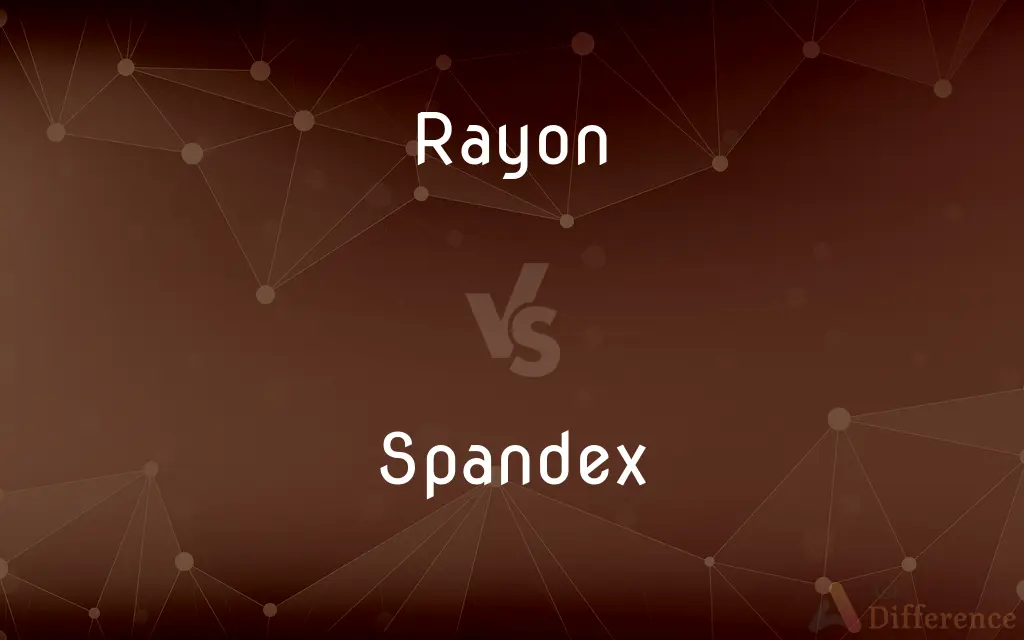Rayon vs. Spandex — What's the Difference?
By Tayyaba Rehman & Fiza Rafique — Updated on April 24, 2024
Rayon, a semi-synthetic fabric made from cellulose, offers a silky texture and breathability, while Spandex, a synthetic fiber, is prized for its exceptional elasticity and strength.

Difference Between Rayon and Spandex
Table of Contents
ADVERTISEMENT
Key Differences
Rayon is produced from regenerated cellulose derived from plants such as wood pulp, giving it a soft and comfortable feel. On the other hand, Spandex is made from polyurethane, which provides significant stretch and recovery properties.
The production process of Rayon involves dissolving cellulose and reforming it into fibers, making it breathable and suitable for warm weather. Whereas Spandex is produced through a dry spinning technique that results in fibers capable of stretching up to five times their original length.
In terms of durability, Rayon is less durable and prone to wrinkling and shrinking if not handled carefully. Meanwhile, Spandex is highly durable, resistant to body oils, perspiration, and detergents.
Rayon is widely used in fashion for its drape and luster, resembling silk, making it ideal for dresses and blouses. Spandex, however, is primarily used in active wear and performance clothing due to its flexibility and comfort during movement.
Environmental impact varies significantly between the two; Rayon's production can be environmentally intensive, often involving hazardous chemicals. Spandex, while also chemical-intensive in production, typically has a longer lifespan, which can mitigate its environmental footprint over time.
ADVERTISEMENT
Comparison Chart
Material Origin
Semi-synthetic, cellulose-based
Synthetic, polyurethane-based
Texture
Soft, silky
Smooth, stretchy
Durability
Less durable, prone to shrinkage
Highly durable, maintains elasticity
Common Uses
Dresses, blouses, soft furnishings
Active wear, undergarments
Environmental Impact
Often uses hazardous chemicals
Chemical-intensive, longer lifespan
Compare with Definitions
Rayon
A versatile fabric known for its silk-like feel.
The dress was made of rayon, which draped beautifully.
Spandex
Often blended with other fibers to enhance stretch.
Cotton-spandex blends are popular for comfort and durability.
Rayon
Requires delicate care.
Always dry clean rayon to maintain its texture and color.
Spandex
Maintains shape over time.
Leggings with spandex do not sag after repeated wear.
Rayon
Made from regenerated cellulose.
Rayon's breathable qualities come from its plant-based cellulose.
Spandex
Known for its exceptional elasticity.
Spandex is essential in sportswear for its flexibility.
Rayon
Susceptible to water damage.
Be careful when washing rayon garments to avoid shrinkage.
Spandex
Resistant to perspiration and body oils.
Gym clothes made of spandex resist odor and degradation.
Rayon
Preferred for warm weather clothing.
Rayon shirts are ideal for summer because they keep you cool.
Spandex
Suitable for high-performance apparel.
Swimmers wear spandex for its streamline and snug fit.
Rayon
Rayon is a synthetic fiber, made from natural sources of regenerated cellulose, such as wood and related agricultural products. It has the same molecular structure as cellulose.
Spandex
Spandex, Lycra, or elastane is a synthetic fiber known for its exceptional elasticity. It is a polyether-polyurea copolymer that was invented in 1958 by chemist Joseph Shivers at DuPont's Benger Laboratory in Waynesboro, Virginia, US.The generic name "spandex", which is an anagram of the word "expands", is the preferred name in North America.
Rayon
Any of several synthetic textile fibers produced by forcing a cellulose solution through fine spinnerets and solidifying the resulting filaments.
Spandex
A type of stretchy polyurethane fabric
Gold spandex leggings
Rayon
A fabric so woven or knit.
Spandex
A synthetic fiber or fabric made from a polymer containing polyurethane, used in the manufacture of elastic clothing.
Rayon
A manufactured regenerated cellulosic fiber.
Spandex
Of or relating to spandex or its elastic qualities.
Rayon
Ray; beam.
Spandex
A synthetic fibre known for its exceptional elasticity.
Rayon
A synthetic fiber, made of thin filaments of regenerated cellulose, extruded from a solution of viscose. Called also viscose fiber and viscose rayon fiber.
Spandex
Clothing made from such material.
Rayon
A textile fabric made from rayon{1}.
Spandex
An elastic textile material, used for clothing
Rayon
A synthetic silklike fabric
Spandex
An elastic synthetic fabric
Common Curiosities
What is Spandex?
Spandex is a synthetic fiber known for its exceptional elasticity and durability.
How is Rayon made?
Rayon is made by dissolving cellulose, usually from wood pulp, and regenerating it into fibers.
How is Spandex made?
Spandex is produced by a dry spinning method from polyurethane.
What is Rayon?
Rayon is a semi-synthetic fabric made from cellulose, known for its silk-like feel and breathability.
Can Rayon be used for sportswear?
While Rayon is breathable, it is not typically used for sportswear due to its lack of elasticity.
Is Spandex good for the environment?
Spandex is chemical-intensive in production, which can be harmful, but its durability might offset its environmental impact.
Is Spandex breathable?
Spandex is less breathable compared to natural fibers but is often blended to enhance comfort.
What garments are best made from Rayon?
Rayon is ideal for dresses, blouses, and lightweight trousers.
Does Rayon shrink?
Yes, Rayon can shrink if not washed and cared for properly.
What garments are best made from Spandex?
Spandex is best used in active wear, undergarments, and performance clothing.
Share Your Discovery

Previous Comparison
Gazebo vs. Pagoda
Next Comparison
Snooze vs. AlarmAuthor Spotlight
Written by
Tayyaba RehmanTayyaba Rehman is a distinguished writer, currently serving as a primary contributor to askdifference.com. As a researcher in semantics and etymology, Tayyaba's passion for the complexity of languages and their distinctions has found a perfect home on the platform. Tayyaba delves into the intricacies of language, distinguishing between commonly confused words and phrases, thereby providing clarity for readers worldwide.
Co-written by
Fiza RafiqueFiza Rafique is a skilled content writer at AskDifference.com, where she meticulously refines and enhances written pieces. Drawing from her vast editorial expertise, Fiza ensures clarity, accuracy, and precision in every article. Passionate about language, she continually seeks to elevate the quality of content for readers worldwide.














































